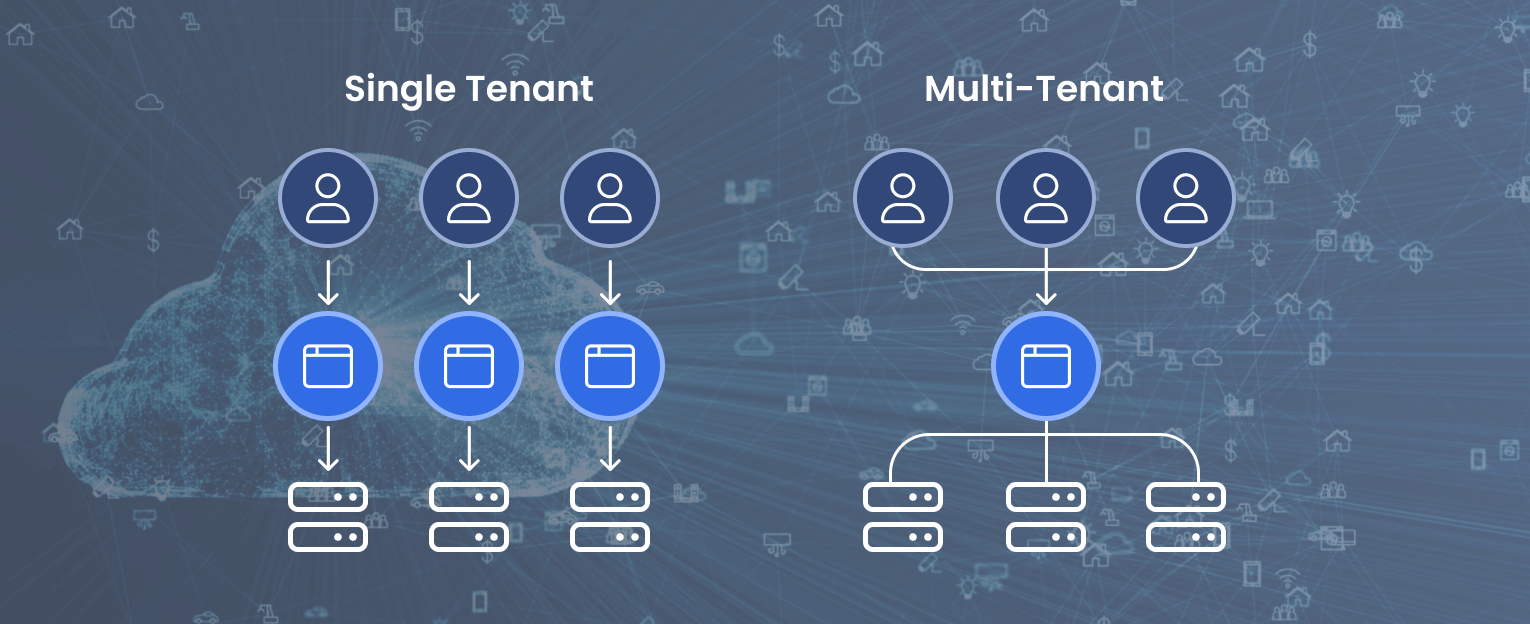The term ‘tenant’ in cloud computing refers to a unit of isolation within a larger system. This can be an organization, an application, or a group of users that are being served by a specific instance of the cloud service. When we compare single tenant vs multi tenant, we learn that they can be differentiated in various ways.
Single-tenant architecture involves one instance of a software application. It’s supporting infrastructure serves only one customer. But multi-tenant architecture has multiple customers or ‘tenants’ that use the same instance of a software application–the tenants share the same infrastructure and resources.
Irrespective of how often we use these terms, it can still be confusing, especially when deciding which is best suited for a business.
Let’s dive deeper into comparing single tenant vs multi tenant architecture and see which fits your business needs best!
Single-Tenant Cloud Architecture
Single-tenant architecture is a model where each customer has an exclusive and unique instance of the software and the supporting infrastructure.
This setup establishes a high level of data isolation as the data of one tenant is entirely segregated from others. Examples of single-tenant include a media agency that stores multimedia content on a single-tenant cloud system to ensure faster access and better performance.
This architecture stands out because of its key features. Firstly, it provides robust customization options. This is what allows the clients to tailor applications to their specific needs. In fact, calling it a strong selling point for companies requiring a high degree of personalization would not be wrong.
Moreover, the single-tenant architecture gives greater control over the environment. Therefore, clients can manage updates and changes according to their timelines and business needs.
Benefits of Single-Tenant
1) Enhanced Security and Privacy
In today’s digital era, companies want to protect their sensitive data from cyber threats. A single-tenant environment solves this issue.
Take AWS, for example, AWS services like Amazon EC2 Dedicated Instances, Amazon VPC, and Amazon RDS Dedicated Instances can be deployed in a single-tenant manner.
It means that businesses are not showing their resources to others. Hence, it promises security and privacy. Also, this eliminates the risk of potential data breaches. This gives an edge to single-tenant while comparing single-tenant vs multi-tenant.
2) Greater Control Over Customization and Configuration
With single-tenant architecture, users can tailor the system to their specific needs, improving productivity. Moreover, they are more compliant with strict regulatory requirements.
As data is not shared with others, organizations can ensure they comply with data and privacy management regulations.
3) More Predictable Performance and Scalability
Single-talent leads to predictable performance and scalability. With only one individual to train and manage, it eliminates unnecessary complexities. Thus, a single-talent system can help streamline operations.
Also, bring clarity to workflows. In today’s fast-paced business environment, businesses must stay ahead of the competition. One way to achieve this is by utilizing a single-talent system.
4) Compliance With Strict Regulatory Requirements
Adherence to strict regulatory requirements becomes simpler with single-tenant. Ensuring that an individual follows all necessary compliance procedures is more accessible. This can also save businesses money and time.
Compliance violations can result in costly fines and damage to reputation. With a single-talent system, the risk of non-compliance is significantly reduced. Furthermore, it also helps maintain consistency and accuracy in processes related to compliance.

Craft Your Ideal Platform with Single-Tenant Flexibility
Tailor every detail to fit your business goals and workflow seamlessly.
Drawbacks of Single-Tenant
1) Higher Costs Due to Dedicated Resources
Single-tenant architecture throws higher costs as it is characterized by allocating expensive resources. In this approach, each tenant enjoys their standalone environment. They all consist of individual servers and storage, which are not shared with others.
This is the reason for increased expenditures, particularly when the lack of resource sharing poses a financial challenge for many businesses.
2) Increased Maintenance and Management Overhead
Expect higher maintenance and management when using a single tenant. This is because managing individual tenant environments demands valuable time and effort. The meticulous monitoring and regular updating add a lot to the workload of IT teams.
Resultantly, this amplifies operational costs. Also, it is crucial for organizations to carefully consider the trade-offs before opting for single-tenant setups.
3) Potential for Slower Updates and Feature Releases
A notable drawback of using the tenant is the potential for slower updates and feature releases. Tenants in a shared environment are subject to the provider’s schedule. As a result, there may be delays in receiving updates.
This can limit access to new functionalities and potential improvements. Consequently, it can hinder efficiency and productivity by keeping the tenants stuck with outdated versions. This prevents them from taking advantage of the latest enhancements and optimizations.
Multi-Tenant Cloud Architecture
In this model, a software application serves multiple customers, which means each customer shares the same resources, including servers and databases. They are built on a shared infrastructure provided by the cloud.
Due to maximizing system resources, the respective model proves to be very cost-efficient. It also assists with saving because the expenses are distributed among the tenants. Additionally, multi-tenant architecture boasts scalability too.
A prominent example of this is Microsoft Office 365, a suite of productivity tools that also employs a multi-tenant architecture.
On top of that, this architecture simplifies maintenance through constant updates, too. Another example is the leading customer relationship management (CRM) platform, Salesforce, which uses multi-tenant architecture.
Benefits of Multi-Tenant
1) Lower Costs Due to Shared Resources
What can be a better outcome than ending up with lower costs for any organization? This is undoubtedly one of the most significant advantages of multi-tenant architecture.
They allow cost reduction across different tenants. It is only possible as the expenses related to infrastructure, upgrades, and maintenance are distributed among multiple users. This results in greater efficiency and affordability. This gives an edge to the multi-tenant in comparing multi-tenant vs single-tenant.
2) Easier to Manage and Maintain
One of the best reasons to opt for multi-tenant is that it is easier to manage. The same goes for maintenance.
Since all tenants share the same infrastructure and codebase, in fact, in the process, the administrators can apply the same patches, updates, or even changes across all tenants simultaneously.
This also aids in simplifying the management process in multiple ways, such as streamlining tasks, reducing complexity, and improving overall efficiency.
3) Faster Updates and Feature Releases
Faster updates are synonymous with a multi-tenant model. It is a software architecture that supports multiple users on a single platform.
Eventually, it enables faster updates and feature releases. Businesses can easily streamline the deployment of improvements and new features using the platform. As it makes them instantly available to all tenants.
By consolidating these updates on a unified platform, the multi-tenant model not only elevates the speed of innovation but also enhances the overall user experience.
4) Efficient Use of Resources
Multi-tenant architectures encourage efficient use of resources. Organizations use multi-tenants for numerous benefits. They can optimize resource utilization, minimize waste, and enhance system efficiency.
This approach not only reduces costs but also promotes better scalability and agility, enabling seamless resource provisioning. With its ability to handle varying workloads, multi-tenant architectures provide an excellent foundation for organizations to thrive in today’s dynamic business market.

Stay Agile in a Dynamic Business Landscape with Multi-Tenant Agility
Achieve operational nimbleness and embrace change seamlessly with multi-tenant agility at your core.
Drawbacks of Multi-Tenant
1) Potential Security and Privacy Concerns
While multi-tenant architecture offers cost and scalability benefits, security considerations and potential privacy risks should not be underestimated, especially during cloud migration.
The situation can worsen when a security breach risks exposing multiple tenants’ data. Such breaches compromise sensitive information and can lead to financial losses. Even reputational damage is also one of its drawbacks so far.
Concerns about data privacy and security in multi-tenant environments can be addressed by using VPCs to create logically isolated networks.
2) Limited Customization and Control
One potential drawback is the limitation of customization in shared infrastructure and code-based multi-tenant environments. This happens due to the shared nature of the resources, as there are restricted options for customization.
It also poses challenges for businesses with specific requirements. The lack of control also hinders the tailored solutions. It will eventually limit the flexibility and adaptability of the system.
3) Risk of Resource Contention
Resources and memory are shared among multiple users in a multi-tenant environment. This sharing can induce the risk of resource contention. Simply put, resource competition happens when one user demands a lot of resources, causing competition for limited resources.
This competition can even affect the performance of other users. This can be very harmful since it can affect the overall system performance. Moreover, it can compromise the responsiveness of certain services.
When to Use Single-Tenant vs Multi-Tenant?
The use of single tenant vs multi tenant database depends on how customers access the software. Some providers offer managed single-tenant cloud services to customers. They take care of infrastructure management and maintenance while still providing dedicated resources.
Multi-tenant is preferable by customers for cost-effectiveness and ease of scalability. Let’s see when you can use single tenant vs multi tenant architecture!
You can use single-tenant when you want to
- Ensure the secure handling of compassionate data.
- Adhere to strict regulatory requirements, either set by governing bodies or industry standards.
- Need extensive customization and control over infrastructure.
- Need to implement mission-critical applications is vital for performance.
You can use multi-tenant when you want to
- Leverage the advantages of cloud infrastructure to reduce expenses on costly hardware investments.
- Deploy standardized applications. Probably the ones with fewer customization requirements.
- Need a reliable and secure option for critical and non-critical applications.
DevOps consultants can assess your unique requirements and industry regulations to determine the most suitable architecture, ensuring compliance and security best practices.
Single-Tenant vs Multi-Tenant Examples
Single-tenant
High-end banking software: A large financial institution might opt for a single-tenant deployment of banking software. This gives them complete control over the environment, data security, and customization. Think of it as having a dedicated bank office just for your accounts.
Custom enterprise resource planning (ERP) system: A manufacturing company with complex production processes might need a tailor-made ERP system built and hosted just for them. This ensures the system aligns perfectly with their specific needs, and data security is paramount. These systems provide the flexibility to customize the application as per specific workflows.
Private cloud environments: Businesses with strict data privacy and control requirements might build their own private cloud environments, essentially single-tenant clouds. Think of it as having your own secure island in the digital ocean.
Multi-tenant
Online email services: Gmail, Outlook, and Yahoo Mail are classic examples of multi-tenant applications. They share the same infrastructure and codebase but provide separate data compartments for each user. It’s like living in a well-managed apartment building with individual apartments for everyone.
E-commerce platforms: Shopify and BigCommerce are multi-tenant platforms that host thousands of online stores. Each store gets its own space and customization options, but the underlying platform is shared. Picture a shopping mall with different shops, each with its own brand and products.
Project management software: Tools like Asana and Trello operate multi-tenant, allowing teams to collaborate on projects while keeping their data separate. Imagine a shared workspace where multiple teams have their desks and projects but share the building amenities.
Conclusion
Ultimately, the choice between single tenant vs multi tenant mainly relies upon specific business objectives. Both have their merits and demerits.
The selection solely rests on determining which benefits align most closely with your business goals. However, this also necessitates developing a deep understanding of single tenant vs multi tenant pros and cons.
Single-tenant architecture may provide more control and customization options. However, it will not be as easily scalable for future growth. In contrast, a multi-tenant architecture offers greater scalability and cost-effectiveness. But at the cost of limited customization options.
Without a deep acknowledgment of these differences, find the right cloud service expert will not be possible. An informed decision is essential to help serve your organization’s needs effectively.
This approach offers numerous benefits that can contribute to an organization’s overall milestones. So, carefully consider the features and decide what will pave the way for success.














